- All Products
- Luminicell Tracker™ - Cell Labelling Kit
Luminicell Tracker™ - Cell Labelling Kit
https://www.idylle-labs.com/shop/luminicell-tracker-tm-cell-labelling-kit-505 https://www.idylle-labs.com/web/image/product.template/505/image_1920?unique=7bbd9feFluorescent cytosolic markers for noninvasive long-term cell tracking
The Luminicell Trackers™ are a novel family of ultra-bright, long-lived fluorescent cytosolic markers with low cytotoxicity for in vitro & in vivo long-term live cell tracking. Once internalized, the labelled dyes can be tracked up to 10 generations in vitro and up to 6 weeks in vivo.
Extending cell tracking time: thanks to excellent cell retention properties, cells remain fluorescently tagged for up to 10 generations in vitro and 6 weeks after in vivo transplantation with no cross-talk, unlocking new potential for long-term monitoring of cell fate & distribution.
Low toxicity: >95% cell viability after 48h and no disruption of normal cell functions.
High brightness & photostability: >10X fluorescent intensity compared to quantum dots, low background auto-fluorescence and >90% fluorescence signal retention after 30 min of continuous laser excitation.
Fast & easy: simply add
Luminicell Tracker™
to your cells and get a >99% labeling rate in less than an hour. Thanks to their simple protocol, LuminiCell trackers do not require any transfection step and can be easily integrated within your existing workflow.
Versatile: with their excellent biocompatibility, deep penetration depth and high compatibility with multiphoton microscopy,
Luminicell Tracker™
will allow you to perform long-term cell tracking in a variety of samples ranging from 2D & 3D cell cultures, live tissues to small animal models.
Luminicell Tracker™ - Cell Labelling Kits are available as blue, green, red, NIR-I & NIR-II fluorescent compounds to match biological optical window.
How does Luminicell Trackers work?
Luminicell Trackers™ are organic fluorescent nanoparticles. They are composed of unique Aggregation Induced Emission (AIE) dyes, at the heart of
Luminicell Tracker™
technology, encapsulated into lipid nanoparticles with proprietary surface. This novel class of materials emit fluorescence in an opposite manner compared to conventional fluorophores (quantum dots, GFP, etc). These unique spectral properties protect them from aggregation-caused quenching, resulting in high signal-to-noise ratio and strong photobleaching resistance, making them optimal candidates for long-term live cell tracking experiments.
Luminicell Tracker™ shows excellent biocompatibility and long-term cell retention properties for in vitro & in vivo applications. Once internalized, Luminicell Trackers™ provide an even labelling of the cytoplasmic matrix retained for up to 10 cell generations.

Find out more about the patented Luminicell Tracker™ proprietary technology platform and its well-recognized track records in our Publications section.
Applications of Luminicell Trackers
The low toxicity and long-lasting nature of Luminicell Tracker™ signal allow a wide variety of cell tracking applications both in vitro and in small animal models (i.e. cell distribution, mobility, cell-cell interactions, etc) to suit your studies from fundamental research to translational & pre-clinical studies.
Sample types:
Luminicell Trackers™
show efficient labelling rate (>99%) in a wide range of adherent & suspension cell lines and primary cells, live & fixed. Their deep penetration depth makes
Luminicell Trackers™
suitable for labelling 3D cell culture models and tissues.
Check out our FAQ section for a full list of validated samples extracted from selected publications.
Experimental outputs:
Once labelled, cells can be imaged in vitro and will remain fluorescently tagged
for up to 10 generations.
Luminicell Trackers™
of different colors can be multiplexed for use in co-cultures or 3D models with no cross-talk.
Cells labelled with
Luminicell Tracker™
can be injected into small animal models for long-term in vivo live cell tracking (up to 42 days), or subsequent ex vivo imaging of extracted organs or tissue sections. So far, they have been successfully used for cell tracking in mice and 3 dpf zebrafish.
Compatible imaging modes: Luminicell Tracker™ labeled cells can be monitored using a variety of fluorescence techniques such as epifluorescence & confocal microscopes, in vivo imaging systems (i.e. IVIS Spectrum) and flow cytometry.
Luminicell Tracker™ is compatible with multiphoton excitation microscopy. Five different versions of
Luminicell Tracker™
with blue, cyan, green, red, NIR-I & NIR-II emission colours are available for purchase through our current catalog.
Check out our Technical Specifications section for full details about optical properties and compatible instrument parameters.
Case studies: Among other applications,
Luminicell Trackers™
have been successfully used in regenerative therapy and immunotherapy development to monitor retention and biodistribution of therapeutic/engrafted cells at the single-cell resolution, tissue and whole organism scale.
Discover more about these case studies and many more in our Results and Publications sections.
Additional resources
Discover more about Luminicell trackers and their use for long-term live cell imaging with this on-demand seminar:
The
Luminicell Tracker™
probes are provided in various emission colors. Choose among our available catalog to fit your desired applications:
Luminicell Tracker™ 1010 - Cell Labelling Kit (NIR-II)
Optical properties:
Absorption max = 725 nm
Emission max = 1010 nm
Compatible instrument parameters:
Laser excitation λ (nm): 355/405/633/755*
Filter sets (nm): > 1000
Laser excitation λ (nm) - Two-photon: 1400
*best excitation wavelength for fluorescent signal
-
Concentration: 200 nM in ultrapure water
Pack size:
- Trial vial (up to 20 assays): 1x 100 µL
- Standard vial (up to 50 assays): 1x 250 µL
Luminicell Tracker™ 810 - Cell Labelling Kit (NIR-I)
Optical properties:
Absorption max = 635 nm
Emission max = 810 nm
Compatible instrument parameters:
Laser excitation λ (nm): 355/543/633*/755
Filter sets (nm): 700 - 1000
Laser excitation λ (nm) - Two-photon: 1200
*best excitation wavelength for fluorescent signal
-
Concentration: 200 nM in ultrapure water
Pack size:
- Trial vial (up to 20 assays): 1x 100 µL
- Standard vial (up to 50 assays): 1x 250 µL
Luminicell Tracker™ 670 - Cell Labelling Kit (Red)
Optical properties:
Absorption max = 506 nm
Emission max = 670 nm
Compatible instrument parameters:
Laser excitation λ (nm): 355/458/488*/543
Filter sets (nm): 670 - 800
Laser excitation λ (nm) - Two-photon: 820*/840/920
*best excitation wavelength for fluorescent signal
-
Concentration: 200 nM in ultrapure water
Pack size:
- Trial vial (up to 20 assays): 1x 100 µL
- Standard vial (up to 50 assays): 1x 250 µL
Luminicell Tracker™ 540 - Cell Labelling Kit (Green)
Optical properties:
Absorption max = 423 nm
Emission max = 540 nm
Compatible instrument parameters:
Laser excitation λ (nm): 355/405*/458/488
Filter sets (nm): 480 - 560
Laser excitation λ (nm) - Two-photon: 800
*best excitation wavelength for fluorescent signal
- Concentration: 200 nM in ultrapure water
Pack size:
- Trial vial (up to 20 assays): 1x 100 µL
- Standard vial (up to 50 assays): 1x 250 µL
Luminicell Tracker™ 470 - Cell Labelling Kit (Blue)
Optical properties:
Absorption max = 355 nm
Emission max = 470 nm
Compatible instrument parameters:
Laser excitation λ (nm): 355*/390
Filter sets (nm): 400 - 500
*best excitation wavelength for fluorescent signal
- Concentration: 200 nM in ultrapure water
Pack size:
- Trial vial (up to 20 assays): 1x 100 µL
- Standard vial (up to 50 assays): 1x 250 µL
Luminicell Tracker™ 506 - Cell Labelling Kit (Cyan)
Optical properties:
Absorption max = 355 nm
Emission max = 506 nm
Compatible instrument parameters:
Laser excitation λ (nm): 355*/405
Filter sets (nm): 420 - 520
*best excitation wavelength for fluorescent signal
- Concentration: 200 nM in ultrapure water
Pack size:
- Trial vial (up to 20 assays): 1x 100 µL
- Standard vial (up to 50 assays): 1x 250 µL
Storage: Luminicell Tracker™ probes can be stored at 2-8°C for up to 18 months. Do not freeze.
Each 250 µL vial provided in the Luminicell Tracker™ - Cell Labelling Kit allows for 25 mL total imaging medium when used at the recommended 2 nM concentration.
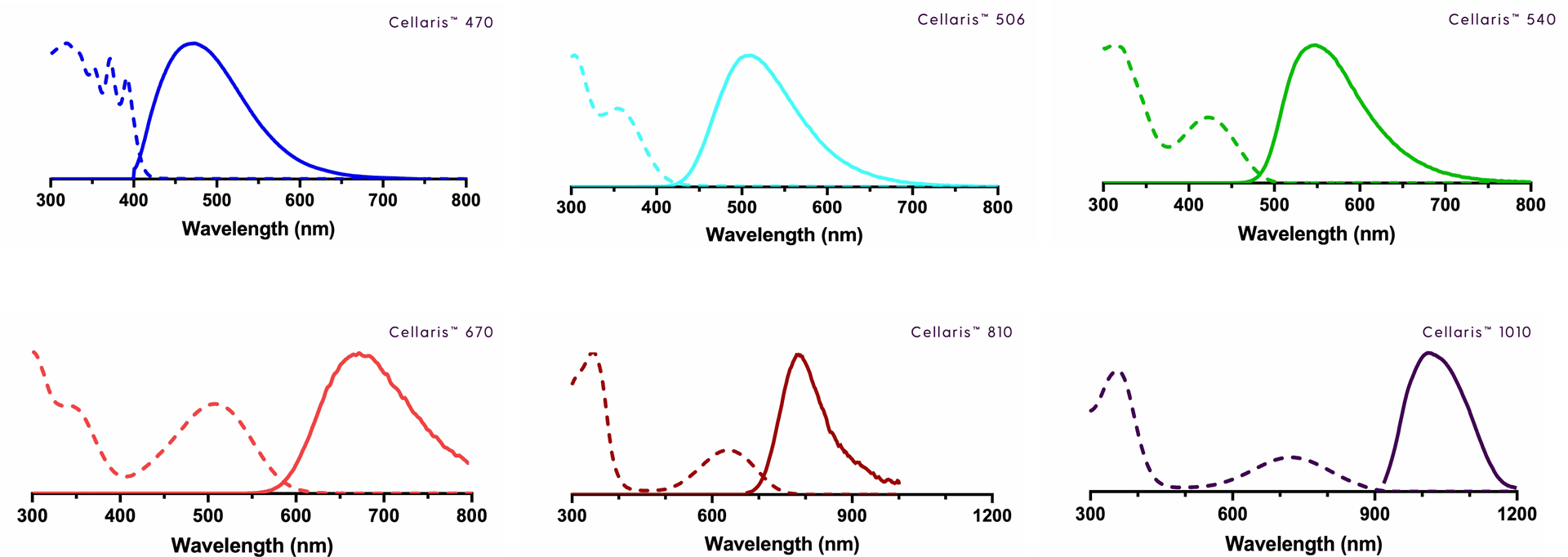
UV-vis absorption (dashed) and emission (solid) spectra of Luminicell Trackers in water
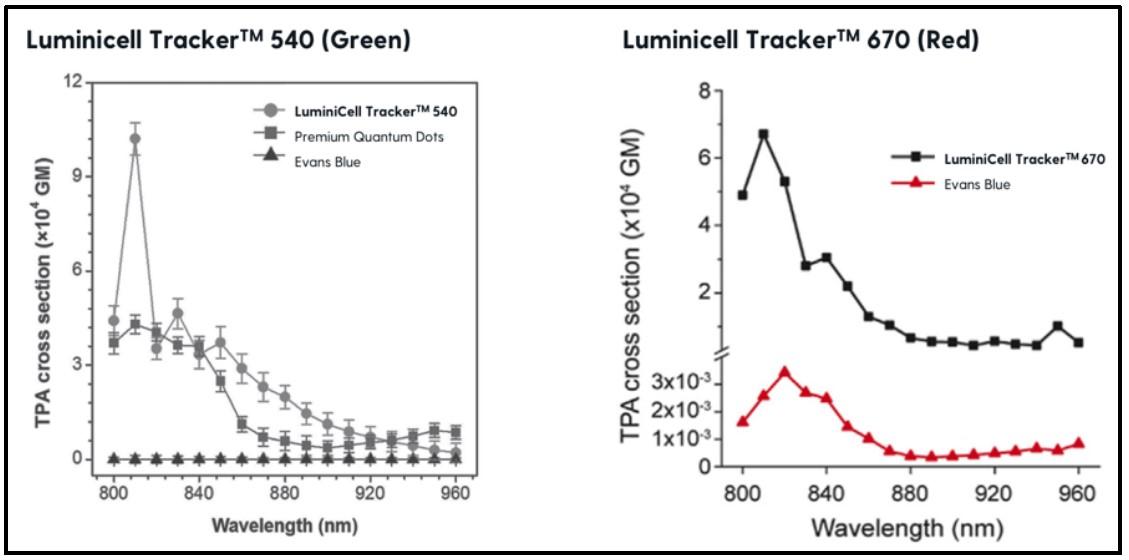
Two-photon absorption spectra of Luminicell Tracker 540 (green) and Luminicell Tracker 670 (red)
Enhanced capabilities of Luminicell Trackers for long-term tracking of adipose-derived stem cells
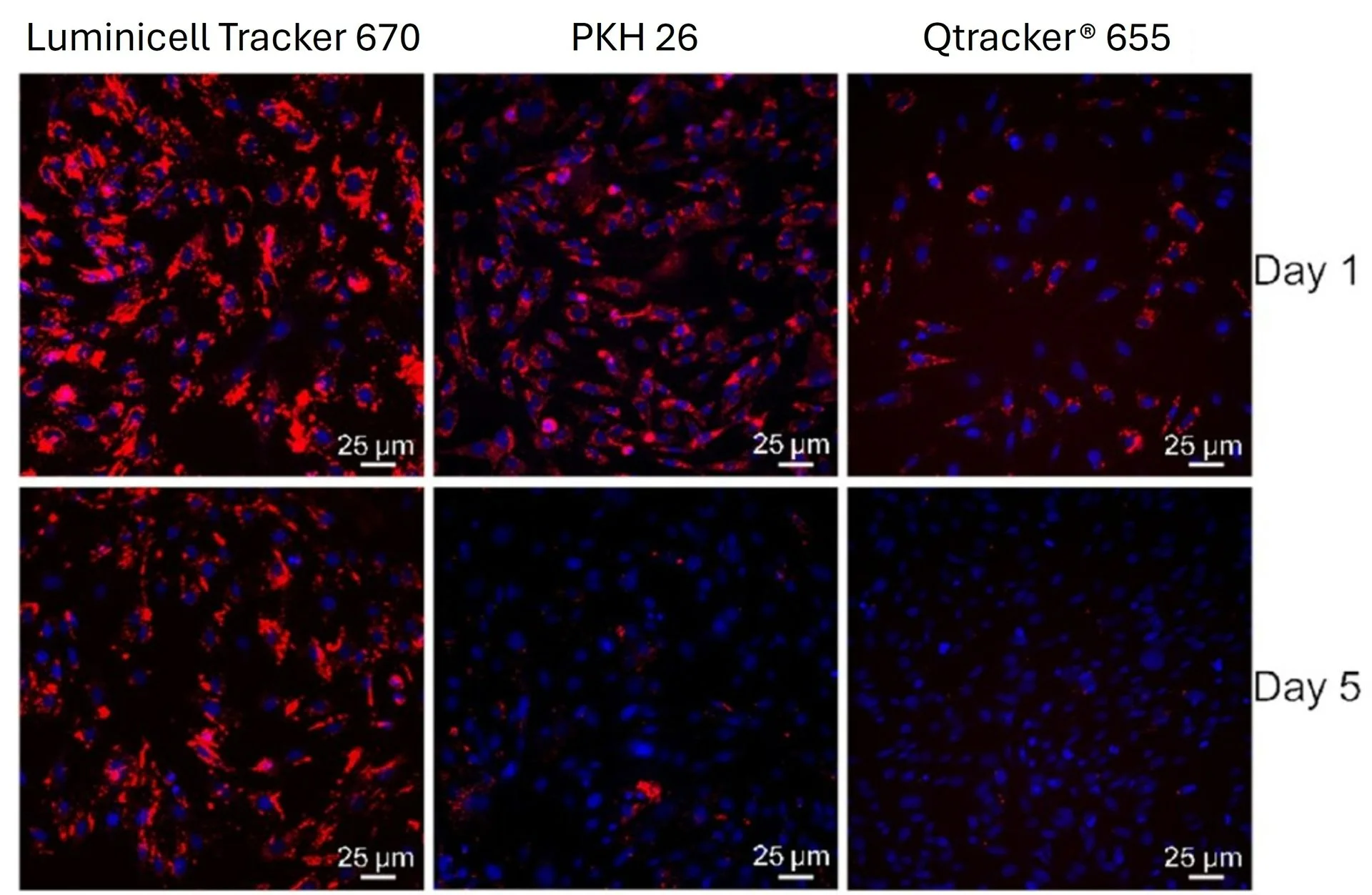
Tumour monitoring using NIR-II with Luminicell Trackers 1010

Assessing cell distribution during 3D spheroid growth using Luminicell Trackers
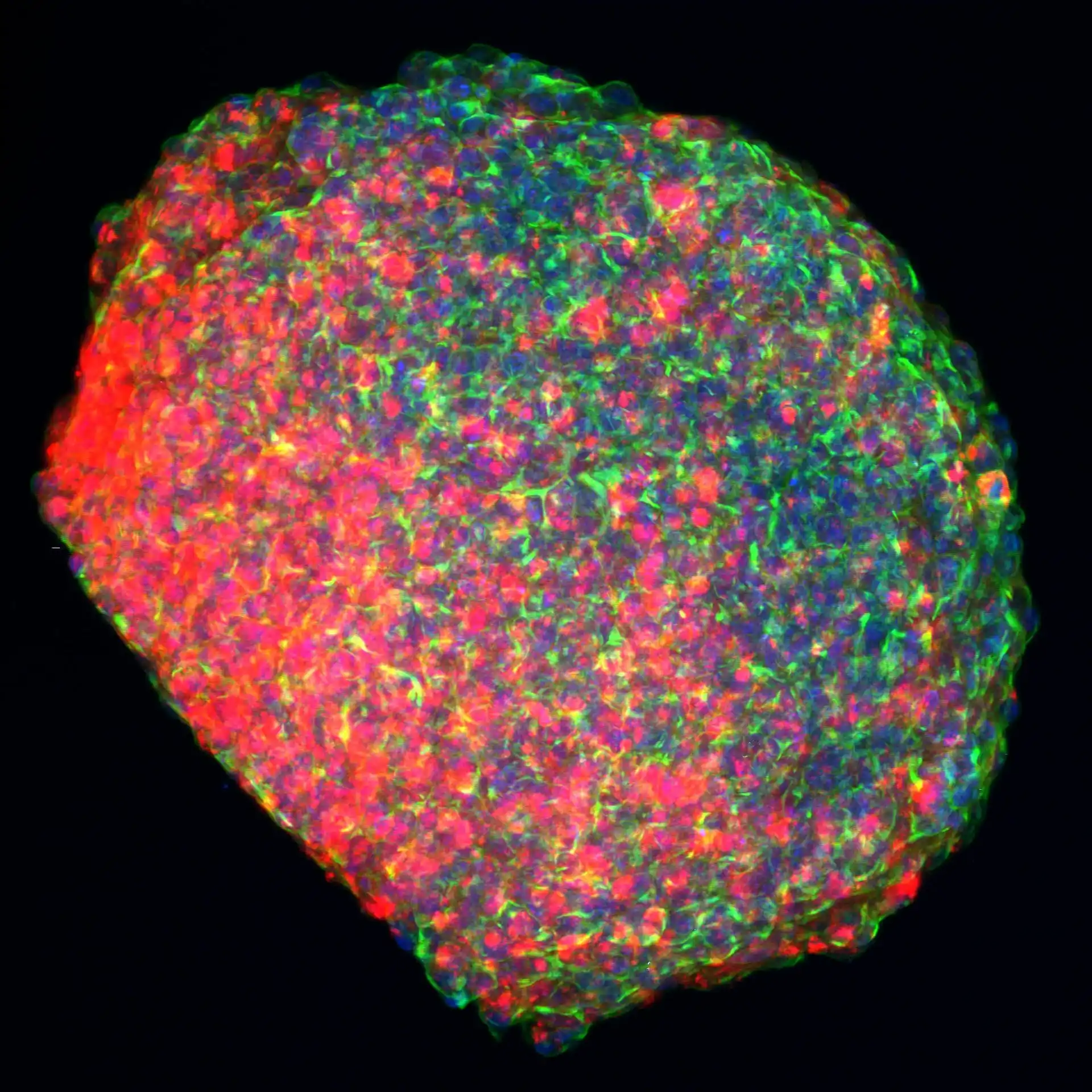
Credits: Yasemin Geiger and Dr. Stefanie Sudhop, CANTER Lab (University of Applied Sciences, Munich).
Luminicell Trackers allow clear distinction between different cell types in co-culture invasion assays
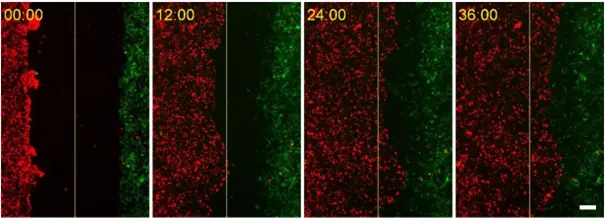
Luminicell Trackers exhibits no cross-talk effects in multi-colored experiments
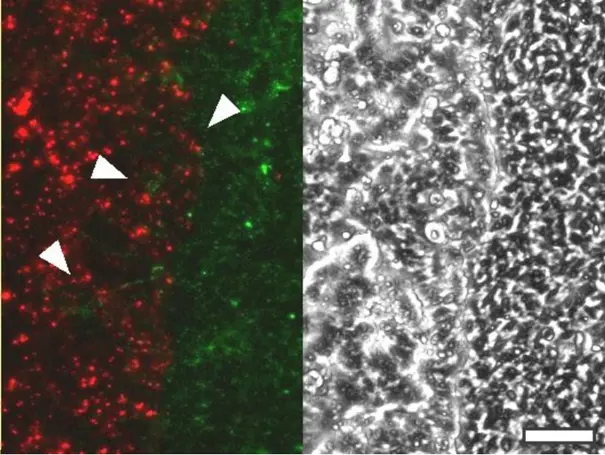
Long-term in vivo tracking of transplanted stem cells using Luminicell Trackers
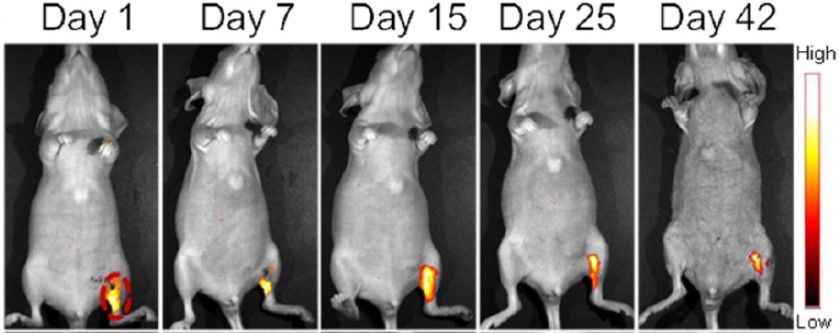
In vivo tracking of transplanted stem cells at single-cell resolution
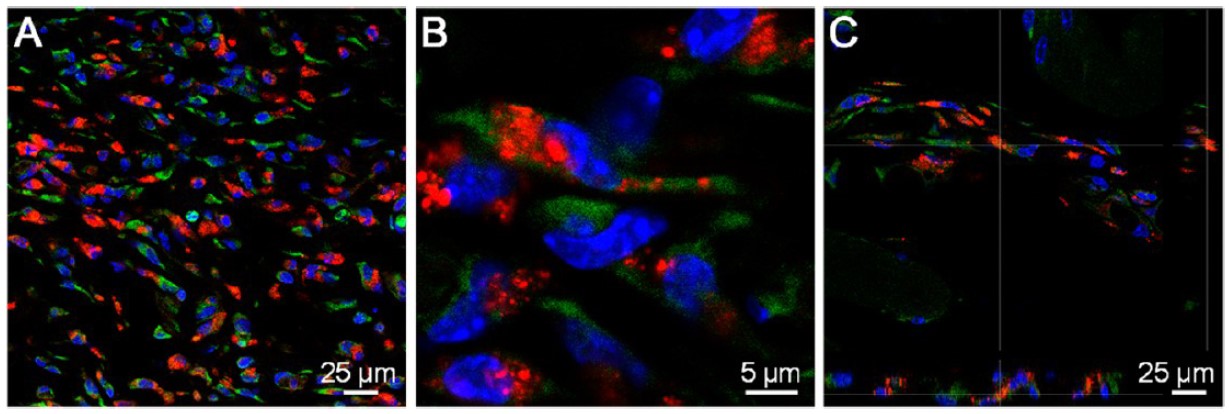
Source publication: Dan Ding et al. (2014). Precise and Long-Term Tracking of Adipose-Derived Stem Cells and Their Regenerative Capacity via Superb Bright and Stable Organic Nanodots. ACS Nano 8 (12), 12620-12631. https://doi.org/10.1021/nn505554y
Multicellular 3D Blood-Brain Barrier (BBB) model
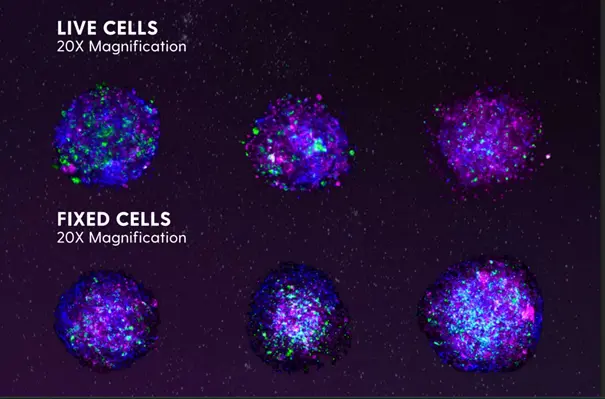
Source: Multicellular 3D Blood-Brain Barrier (BBB) model (see Publication section)
In vitro 3D tissue culture model of fibrotic liver
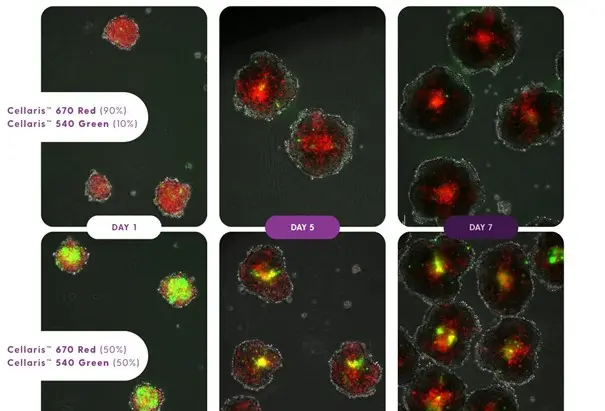
Organoids incubated with ClinoStar®.
Source: In vitro 3D tissue culture model of fibrotic liver (see Publication section)
How to use Luminicell Trackers:
Yes, Luminicell Trackers™ are stable at room temperature for a few days. However, it is strongly recommended to store all probes or solutions thereof at the recommended storage conditions of 4°C. Do not freeze Luminicell Trackers™.
No cytotoxic effects have been reported with Luminicell Trackers™
when using them at the recommend working concentrations of 2 to 10 nM. Their inherent brightness and photostability makes it possible to use this concentration range, which is in the order of multiple magnitudes lower than comparable live cell stains. Some effects on cell proliferation might be observed only if using concentrations above 10 nM.
Yes, once internalized, the
Luminicell Trackers™ are retained in the cytoplasmic matrix and transfer to daughter cells up to 10 generations
without leaking
due to their excellent retention in living cells.
Yes. With their exceptional high brightness, high cross-sectional area for two- and three- photon absorption and good photo-stability, Luminicell Trackers™ are the ideal choice for Two-Photon and Multi-photon Excitation Microscopy. They are probably the brightest probes available on the market!
Learn more about applications using luminicell probes with Two-Photon Excitation Microscopy in our Publications section.
The list below reports known working cell lines, tissues or organisms that can be stained with Luminicell Trackers™ extracted from selected publications.
Homo sapiens : U2OS, fibroblasts, HeLa, HUVEC, MCF-10A,
MDA-MB-157, HCT-116, A549, OS143b, erythrocytes, hASCs, hMSCs
Mus musculus : C2C12, IA32, skeletal muscle, primary cardiomyocyte, primary oocyte, pancreatic stellate cells.
Rattus norvegicus : primary hyppocampal neurons, primary cortex neurons, NRK, BM-MSCs.
Cercopithecus aethiops : COS-7.
Mesocricetus auratus : BHK.
Drosophila melanogaster : Notum epithelium, S2.
Didelphis marsupialis : OK-cells.
Carassius auratus (goldfish) : retina bipolar cells
Danio rerio (zebrafish) : retina bipolar cells
Dog: adult canine dermal fibroblasts (ACDFs)
Porcine urothelial & mammary glandular cells
Labelled cells have been successfully injected in small animal models (i.e. mice, rats & zebrafish) for in vivo & ex vivo imaging.
Please note that above list shown is non-exhaustive. Any cell line, tissue or organism is not included in list, does not translate to limitation in product staining performance.
Yes, Luminicell Trackers™ Cell Labelling Kits are able to stain cell grown in a 3D environment such as spheroids, organoids or multi-layer cell sheets.
Yes, Luminicell Trackers™ Cell Labelling Kits are able to stain primary cells with minimal cytotoxicity. Validation in various experimental series can be found in our Publications section.
No, Luminicell Trackers™ Cell Labelling Kits are cytosolic trackers developed for long-term live-cell staining by evenly labelling cytoplasmic matrix. The probes do not bind to sub-cellular structures, nor label sub-cellular domains such as the nucleus.
We do not use nor introduce any amount of DMSO into the products throughout the manufacturing processes of Luminicell Trackers™. They are provided as a nanoparticle suspension in ultrapure water.
The Luminicell Trackers are not designed for extracellular vesicles labelling, as the labelling mechanism depends largely on the live cell uptake.
Nanoparticle surface is PEGylated and conjugated to cell-penetrating peptides (CPP) for enhanced cell uptake. Custom surface chemistries are available upon request. For custom orders, please contact [email protected].
Publications about Luminicell Trackers
Case studies:
Multicellular 3D Blood-Brain Barrier (BBB) model
In vitro 3D tissue culture model of fibrotic liver
Application notes:
Spheroid labelling with Cellaris and MPS-1030 for two-photon imaging
Co-Culture Invasion Assay Using the Culture-Insert 2 Well and the Live Cell Labeling Kit Cellaris™
Selected published studies using Luminicell trackers:
Arriaga, J.M., Ronaldson-Bouchard, K., Picech, F. et al. In vivo genome-wide CRISPR screening identifies CITED2 as a driver of prostate cancer bone metastasis. Oncogene 43, 1303–1315 (2024). https://doi.org/10.1038/s41388-024-02995-5 (Luminicell Tracker 670)
Cacciottola, L., Vitale, F., Donnez, J., et al. (2023) Use of Mesenchymal Stem Cells to Enhance or Restore Fertility Potential: A Systematic Review of Available Experimental Strategies. Human Reproduction Open, 2023(4), https://doi.org/10.1093/hropen/hoad040 (Luminicell Tracker 540)
Arai, K., Saito, F., Miyazaki, M., et al. (2023) Small Molecules Temporarily Induce Neuronal Features in Adult Canine Dermal Fibroblasts. Int. J. Mol. Sci. 2023, 24(21), 15804. https://doi.org/10.3390/ijms242115804 (Luminicell Tracker 540)
Huang, C. P., Lu, H. L., & Shyr, C. R. (2023). Anti-Tumor Activity Of Intratumoral Xenogeneic Urothelial Cell Monotherapy Or In Combination With Chemotherapy In Syngeneic Murine Models Of Bladder Cancer. American journal of cancer research, 13(6), 2285–2306 https://www.ncbi.nlm.nih.gov/pmc/articles/PMC10326576/ (Luminicell Tracker 670)
Kojima, H., Kushige, H., Yagi, H., et al. (2023). Combinational Treatment Involving Decellularized Extracellular Matrix Hydrogels with Mesenchymal Stem Cells Increased the Efficacy Of Cell Therapy In Pancreatitis. Cell Transplantation, 32,
https://doi.org/10.1177/09636897231170437 (Luminicell Tracker 670)
Chikashi, W., Higashi, T., Hayashi, H., et al. (2023). Potential Activity of Adiponectin-Expressing Regulatory T Cells Against Triple-Negative Breast Cancer Cells Through the Cell-In-Cell Phenomenon. Thorac Cancer. 2023; 14: 1941 – 1945.
https://doi.org/10.1111/1759-7714.14940
(Luminicell Tracker 670)
Dahal, S., Dayal, S., et al. (2022). Adult Mesenchymal Stem Cells and Derivatives in Improved Elastin Homeostasis in a Rat Model of Abdominal Aortic Aneurysms. Stem Cells Translational Medicine, 11(8), 850-860. https://doi.org/10.1093/stcltm/szac043 (Luminicell Tracker 670)
Huang, C.-P., Liu, L.-C., et al. (2022). Intratumoral Xenogeneic Tissue-Specific Cell Immunotherapy Inhibits Tumor Growth By Increasing Antitumor Immunity In Murine Triple Negative Breast And Pancreatic Tumor Models. Cancer Letters, 545, 115478- 115478.
https://doi.org/10.1016/j.canlet.2021.10.044 (Luminicell Tracker 670)
Kishi, S., Fujiwara-Tani, R., et al. (2022). Oxidized High Mobility Group B-1 Enhances Metastability of Colorectal Cancer Via Modification of Mesenchymal Stem/Stromal Cells. Cancer Science, 113(8), 2904-2915. https://doi.org/10.1111/cas.15400 (Luminicell Tracker 540)
Naderi-Meshkin, H., Eleftheriadou, M., et al. (2022). Impaired Function in Diabetic Patient iPSC-Derived Blood Vessel Organoids Stem From a Subpopulation of Vascular Cells. bioRxiv, 2022.2007.2018.500478. https://doi.org/10.1101/2022.07.18.500478 (Luminicell Tracker 670)
Jang, S. E., Qiu, L., et al. (2021). Aggregation-induced emission (AIE) Nanoparticles Labeled Human Embryonic Stem Cells (hESCs)-Derived Neurons for Transplantation. Biomaterials, 271, 120747-120747. https://doi.org/10.1016/j.biomaterials.2021.120747 (Luminicell Tracker 670)
Salvatore, G., De Felici, M., et al. (2021). Human Adipose-Derived Stromal Cells Transplantation Prolongs Reproductive Lifespan on Mouse Models of Mild and Severe Premature Ovarian Insufficiency. Stem Cell Research & Therapy, 12(1), 537-537.
https://doi.org/10.1186/s13287-021-02590-5 (Luminicell Tracker 540)
Kc, P., Shah, M., et al. (2020). Preseeding of Mesenchymal Stem Cells Increases Integration of an iPSC-Derived CM Sheet into a Cardiac Matrix. ACS Biomaterials Science & Engineering, 6(12), 6808-6818. https://doi.org/10.1021/acsbiomaterials.0c00788 (Luminicell Tracker 540 & 670)
Rojas-Torres, M., Jiménez-Palomares, M., et al. (2020). REX-001, a BM-MNC Enriched Solution, Induces Revascularization of Ischemic Tissues in a Murine Model of Chronic Limb- Threatening Ischemia. Frontiers in Cell and Developmental Biology, 8.
https://doi.org/10.3389/fcell.2020.602837 (Luminicell Tracker 540)
Xuan, W., Khan, M., et al. (2020). Extracellular Vesicles from Notch Activated Cardiac Mesenchymal Stem Cells Promote Myocyte Proliferation and Neovasculogenesis. Frontiers in Cell and Developmental Biology, 8. https://doi.org/10.3389/fcell.2020.00011 (Luminicell Tracker 540)
Garg, B., Giri, B., et al. (2018). NFκB in Pancreatic Stellate Cells Reduces Infiltration of Tumors by Cytotoxic T Cells and Killing of Cancer Cells, via Up-regulation of CXCL12. Gastroenterology, 155(3), 880-891.e888. https://doi.org/10.1053/j.gastro.2018.05.051 (Luminicell Tracker 540 & 670)
Kang Y et al. (2016). Long-Term Tracking Mesenchymal Stem Cell Differentiation with Photostable Fluorescent Nanoparticles. ACS Appl Mater Interfaces. 8(19):11925-33. https://doi.org/10.1021/acsami.5b12371
Dan Ding, Duo Mao, Kai Li, Xiaomin Wang, Wei Qin, Rongrong Liu, David Shunzhong Chiam, Nikodem Tomczak, Zhimou Yang, Ben Zhong Tang, Deling Kong, and Bin Liu. (2014). Precise and Long-Term Tracking of Adipose-Derived Stem Cells and Their Regenerative Capacity via Superb Bright and Stable Organic Nanodots. ACS Nano 8 (12), 12620-12631.
https://doi.org/10.1021/nn505554y
Other products you may like
Agarsqueezer
Use the AgarSqueezer confiner to facilitate your single-cell tracking experiments in 3D cell structures.
Stencell
Multiply your experimental conditions to save Luminicell tracker volumes, or use it for live cell tracking during migration.
SpheroTribe
Boost your 3D structure uniformity to simplify your cell tracking assay analysis and get the most reliable data.
Stampwell - zebrafish
Use Stampwell to facilitate imaging of labelled cells in multiple zebrafishes at the same time by immobilizing and aligning them perfectly.
Stampwell - 3D cell structures
Use Stampwell to facilitate imaging of labelled cells in multiple 3D structures at the same time by immobilizing and aligning them perfectly.
GlowMito
Combine Luminicell trackers with GlowMito, also compatible with multiphoton microscopy, and visualize mitochondria during your cell tracking experiments in living cells and thick tissues.